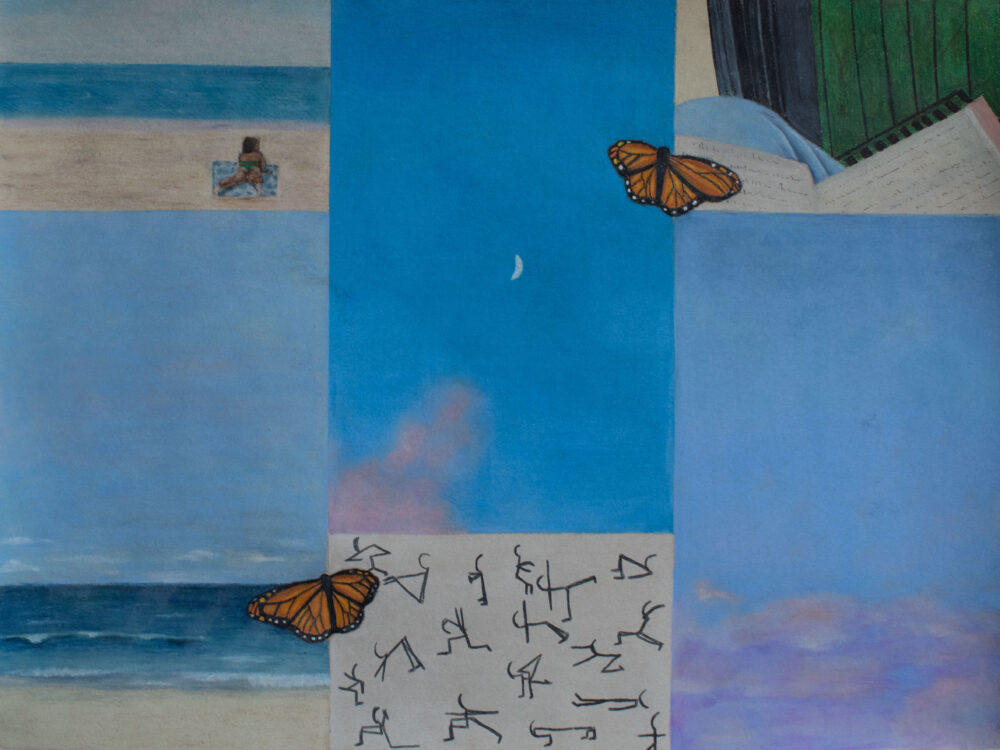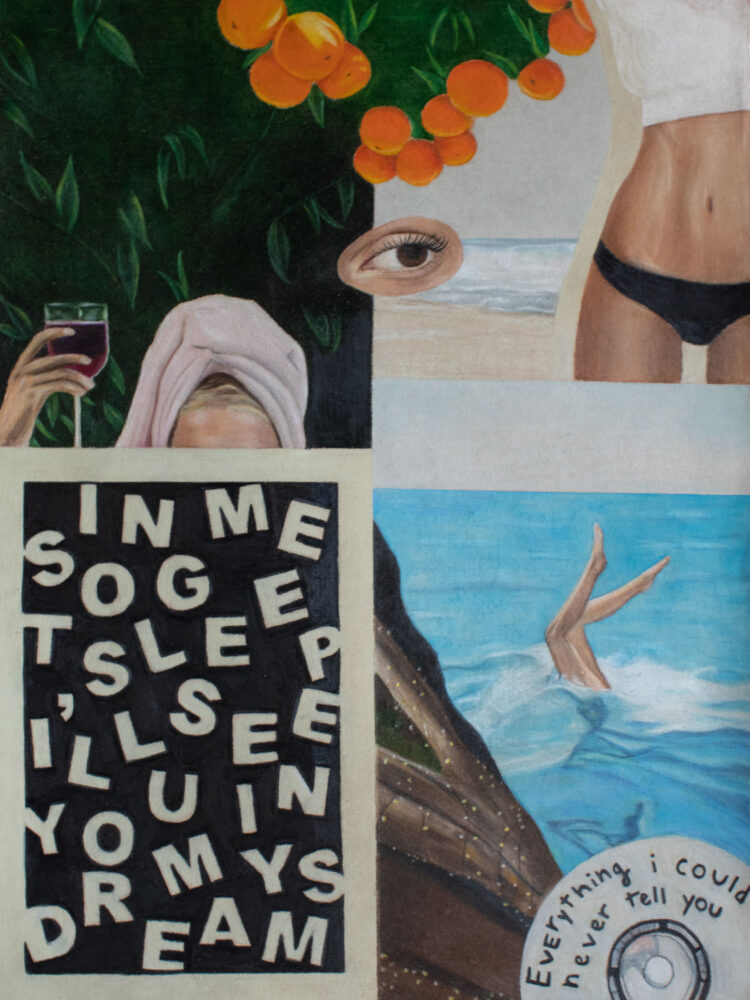What constitutes autobiographical art or self-portraiture?
Visual Memoirs
“Visual Memoirs,” my final project for Professor Lauren Walsh’s Interdisciplinary Seminar “Contemporary Visual Culture and the Politics of Images,” was inspired by a breakout-room discussion about Persepolis (2007). The film is based on Marjane Satrapi’s graphic novels, which are autobiographical works about her childhood and early adulthood. My group agreed that the graphic novels function as an autobiography, but we debated whether or not the film could be classified as such. Members of my group found that dramatizations and discrepancies between the film and novels discredited the work as a memoir. I disagreed. This conversation led me to consider what exactly constitutes an autobiographical work and who decides this. I began to think about examples in art history specifically; Frida Kahlo’s The Two Fridas and Hannah Höch’s Self-Portrait came to mind. I then looked to my own work and considered the same criteria. I create paintings and colored pencil drawings. I have only painted two self-portraits in the traditional sense; both image my face and fit into the genre of self-portraiture. As I reflected on my other works, I realized that they too function as autobiographical works because they represent my experiences in the form of a visual narrative. However, I considered a counter-argument to my thinking and realized that someone else could disagree entirely. This thought is based on the ambiguity of my art as autobiographical works. My pieces explore personal imagery in dialogue in order to create an unclear, intimate narrative.
This thought process led to two drawings which play with the criteria of autobiographical art or self-portraiture. They are nine by twelve-inch colored pencil drawings. I created them with the following criteria for a memoir in mind: the work represents the creator, the work directly images the creator or tells the story of a lived experience, the creator intended for the viewer to identify the narrative, and the creator intended to make an autobiographical work. I decided to keep the subject or central narrative constant but shift the relationship to the viewer. The narrative is my life in 2020, and they are collaged drawings. The first drawing, Home, is meant to be clearly understood by the viewer. The second, Quarantine, is intended to be ambiguous and not clearly understood by the viewer. I hoped that creating these two pieces would offer me clarity on what constitutes an autobiography by looking at my own.
Before looking closer at my own pieces, I will look at the history of collage and self-portraiture to situate my work in a broader art historical context. In “The Invention of Collage” Marjorie Perloff chronicles the genesis of collage and its function in the early 20th Century. He says, “the word collage comes from the French verb coller and means literally ‘pasting, sticking, or gluing,”1 Collages are often made up of pre-existing materials and images, but they bring these images into conversation with others to create new meaning. The first collages were made by Picasso and Braque in 1912 during the Cubist Movement.2 Analytic Cubism expressed an object from multiple perspectives on one plane, while Synthetic Cubism created one dimensional views of objects and often relied on cut-outs. Collage was revolutionary because it allowed for two readings: that of an image in dialogue with others and the original meaning of the image. Most of my own work consists of painted collages that function in this same way.
In “Practices of Looking,” Marita Sturken and Lisa Cartwright explore representation, which they define as “the use of language and images to create meaning about the world around us.”3 I am interested in self-representation for this project. In the same way we represent the world through art, we also represent ourselves. The most common mode of self-representation is the self-portrait, which is traditionally mimetic in imaging the creator. However, images create meaning for ourselves in the same way they do for the world. I believe we can image ourselves by using other images that exist outside of our physical body. Anthony Bond explores the genre of self-portraiture in “Performing the Self?” Self-portraiture originated in the Renaissance as artists wished “to establish their identity and status as creative artists” and situate themselves as elites.4 Bond argues that “the challenge of self-portraiture has become an obsession for many artists.”5 Artists no longer want to be limited to mimetic forms of self-representation but aim to create “representations of artistic creativity.”6 Bond identifies three methods of self-portraiture: the first is mimetic, then identifying the artist by his/her hand in the form of brushwork, etc., and the last is allegories of creativity.7 I am concerned with the allegory of creativity, which I believe has taken on new meaning in modern times.
Frida Kahlo and Hannah Hoch created self-portraits using this allegory of creativity by imaging themselves in dialogue with experience. Frida Kahlo’s The Two Fridas (1939) narrates her identity crisis in the midst of her divorce, while Hannah Hoch’s Self-Portrait (c. 1920) represents her experience of making art. Phaidon’s “Frida Kahlo, Divided” explains, “her divorce from Diego Rivera alongside her divided heritage and medical history is clearly expressed in this powerful painting.”8 The painting shows two versions of Kahlo sitting next to each other; each has an open heart on her chest, which are connected by veins. She holds a pair of scissors in her hand, suggesting a cut from her previous self or an aspect of her identity. Hoch’s Self-Portrait is a collage made in her unique Dada style. Her head is enlarged compared to her body, and one eye is much larger than the other. Like Kahlo, she also holds a pair of scissors. These scissors point to her artistic experience as a collage artist as she cut and pasted images for her works. Both pieces are autobiographical and self-portraits, and they are both arguably collages. Hoch’s is an obvious collage using readymade materials, and Kahlo cut and pasted her body onto the canvas in the display of two Fridas. I looked to these pieces as inspiration for my own autobiographical collages because of the allegories used. They do not rely solely on the image of the maker but include images associated with their identities.

Home is meant to be understood by the viewer as a chronological narrative, and I believe viewers would classify this work as autobiographical over Quarantine. The collage is separated into three sections, and each represents a place I spent time in this year—my three homes. The first is Sydney, Australia the second is Las Vegas, Nevada, and the last is New York, New York. Each section includes a background images I took of the sky in that place and an image I feel represents the time I spent there. I began my year in Sydney studying abroad. The first section includes a background of the beach and a picture of me lying on the beach, which is how I spent almost all of my time. The second section is my hometown, Las Vegas, where I stayed from March to July. The background is of a sunset, and I included line drawings I made while watching a yoga class outside. I worked at a yoga studio during the summer and practiced yoga often. The third section represents New York, where I spent my fall semester. The background is a New York City sunset, and the image is me reading on my fire escape. I spent most of my time at home engaging in activities like reading, so I thought it was the most fitting. The butterflies are meant to represent movement from one place to the next as well as growth.

Quarantine is not meant to be understood by the viewer, and as the creator I believe it is more autobiographical than Home. Although the narrative is not easily understood, its narrative is more authentic and raw than the shallow one told in Home. I chose images that are meant to function in dialogue with each other, but they also hold meaning alone. The narrative is my emotional journey during my quarantine. I would like to keep the entirety of its narrative to myself, but I will explain some aspects. I left Sydney at the end of March as lockdowns began in the U.S. I arrived in Las Vegas and spent the summer months in my home, which I had not spent that much time in since high school. I was longing to be back on the beach in Sydney, and I think most people shared that feeling of wanting an escape. The escape could have been physical or emotional. I also began having extremely vivid dreams, so the piece has an underlying theme of dreaming as well as day dreams. The bottom left portion reads, “sing me to sleep I’ll see you in my dreams.” The eye is the center is mine. I strongly believe this piece is a memoir. However, I have shown it to people close to me, and they were unable to decode its meaning.
These two drawings serve two purposes; they function as autobiographical and tell a narrative. I hoped to come to some realizations while actually making them, and I did. The first was an accident: I included one mimetic image of myself in both drawings, my body lying on the beach in Home and my eye in Quarantine. However, I think both are unrecognizable to a viewer who does not know me well. My intention was to represent myself with images outside of my physical being, but I unintentionally included mimetic images of me. This made me realize that some physical part of the creator should exist in the work for it to be autobiographical. I also unintentionally created art about the act of making art and my role as the artist. Both pieces are obviously and unapologetically collages. They have clean lines and fragments, so their collaged nature cannot be ignored. I also did not mean to use so much blue. I used an entire blue colored pencil for these two drawings. This realization told me a lot about my mood this year: it was very blue. I believe my identity as an artist came through more than anything else while telling these narratives. Possibly that is the identity I choose to present to the world, or it is simply who I am.
In any case, I have concluded as the creator that these are visual memoirs because they are genuine representations of my identity.
- Marjorie Perloff, “The Invention of Collage,” The Futurist Movement: Avant-Garde, Avant-Guerre, and the Language of Rupture (University of Chicago Press, 1986), 46.
- Perloff, “The Invention of Collage,” 46.
- Lisa Cartwright and Marita Sturken, “Practices of Looking,” Practices of Looking: an Introduction to Visual Culture (Oxford University Press, 2018),12.
- Anthony Bond, “Performing the Self?” in Self Portrait: Renaissance to Contemporary, by Anthony Bond and Joanna Woodall (National Portrait Gallery, 2007), 31.
- Bond, “Performing the Self?” 31.
- Bond, “Performing the Self?” 31.
- Bond, “Performing the Self?” 31.
- “Frida Kahlo, Divided.” Phaidon, July 2020.